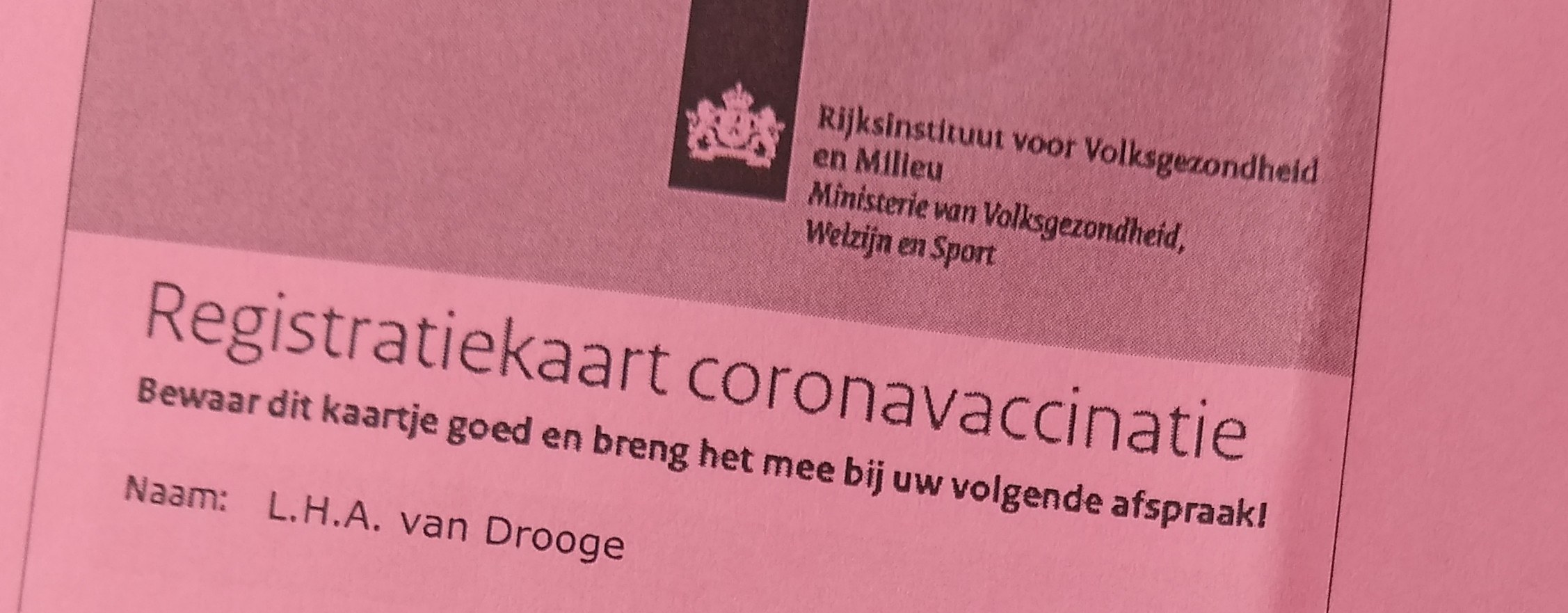Vaccine development in context
CWTS' Leonie van Drooge has received the Moderna vaccine. She is not an army enthusiast, yet she is grateful to the US Dept. of Defense. Its agency DARPA funded Moderna in 2013 to further develop the then-novel mRNA technology. This blog looks into how DARPA does or doesn't solve challenges.
DARPA is one of many examples of how the entrepreneurial state makes high-risk investments and creates markets. DARPA is often referred to when it comes to funding for missions. It is unique and differs in many ways from traditional research agencies. This blog post illuminates some of its particularities; some inspiring, others just interesting, and again others not so pretty.
The Open Access book The DARPA Model for Transformative Technologies: Perspectives on the U.S. Defense Advanced Research Projects Agency as well as the website of DARPA are used for this blog. Before I joined CWTS I worked at Rathenau Instituut. One of the final projects I worked on was dedicated to mission-oriented innovation policies and I did a case study on DARPA. I expect the final report to be published soon.
With a “D” for Defense
The Defense Advanced Research Projects Agency (DARPA) makes, according to its website, pivotal investments in breakthrough technologies for national security.
The mission to ensure national security as well as the relationship with the US army are crucial characteristics. This relationship goes back to the origin of DARPA, the Sputnik shock. In 1957 the Soviet Union is the first to successfully launch a rocket and satellite, named Sputnik, into space. This comes to many as a surprise, not least in the US. In 1958 the US establishes what we now know as DARPA. Its mission is national security, by ensuring the US is the initiator of strategic technological surprises; not the victim.

Replica of the Sputnik 1 satellite
The US army is the client of DARPA. Its programs are based on challenges the army faces and developments the army foresees. DARPA program managers and (office) directors meet with, reach out to and collaborate with army representatives all the time. DARPA will not develop quick fixes nor incremental adaptations; it aims beyond the horizon. Think precision weapons, stealth technology, automated voice recognition, global positioning system (GPS), the Internet.
And mRNA vaccination.
Since a decade or so the human body has been identified as one of the most vulnerable aspects of the US army. The army encounters bioterrorism, sees increasingly serious (brain) injury, operates with smaller units without medics, operates under extreme conditions. And troops encounter infectious diseases.
The client of DARPA
The army is the intended user or buyer of the final product or technology. The importance of this close relationship between agency and user becomes apparent in the case of the Advanced Research Projects Agency-Energy (ARPA-E). ARPA-E is very much based on DARPA, but there are differences. ARPA-E advances high-potential, high-impact energy technologies. It aims for no less than economic prosperity, national security and environmental wellbeing. However, the Department of Energy is not the main client for the technologies ARPA-E develops. It is certain industries, such as aviation in case of innovative electric motors, or homeowners in case of transformative generators. And in many cases energy companies play a key role, either as manufacturer or user.
Industry
This difference between DARPA and ARPA-E sheds light on another key aspect: the industrial landscape, and the willingness and ability of companies to further develop novel technologies. This is not always the case, certainly not in the long-established and traditional energy sector. Existing companies tend to protect their interests. Plus they are not keen to embrace novel technologies.
This is initially the case with mRNA technology as well. In 2012 big and traditional pharmaceutical companies, such as Novartis, Pfizer, AstraZeneca and Sanofi Pasteur, receive funding from DARPA to develop mRNA technology. The results are good, yet the companies lose interest. The novelty of the mRNA technology implies uncertain regulatory pathways. A risk they are unwilling to take.
Enter Moderna, a young start-up founded with venture capital. In 2013 Moderna receives up to 25 Million USD from DARPA.
DARPA often collaborates with young and innovative companies, especially in the fields of information-, communication- and biotechnology and often founded with venture capital. A very different industry landscape from the energy sector.
Begin at the end
If we look closer at DARPA and ARPA-E, it becomes even clearer that they are not your regular research funding agency. One aspect is very prominent, i.e. beginning with the end. It is about the result, a specific solution, that contributes to the mission. The agencies don’t fund research for research’s sake. They invest in technologies that they believe will contribute to national security / economic prosperity / environmental wellbeing. And so the starting point is the potential of a novel technology. DARPA is very much about exploring, challenging and pushing novel technologies; it is not about basic science.
The intervention logic is not the common fund-research-and-breakthroughs-might-happen. It is more like: in order to get to a certain solution and to ensure national security, technological boundaries need to be pushed above and beyond the unimaginable, and by all means necessary. It’s the DARPA program manager that leads the way. Or in case of ARPA-E the program director. Because at ARPA-E they don’t just manage programs, they are in the lead and thus direct.
Vision and religion
The “vision” of the DARPA program manager and the “religion” of the ARPA-E program director serve as a beacon. It is a combination of ideas, knowledge, expertise, networks and insight into the potential of a novel technology. And how combining all that can result into a completely novel solution. The program manager has far more responsibilities and possibilities than any officer at a regular research council.
A program manager is expected to develop programs and do so by engaging with DARPA (office) directors, the army, researchers at universities and government labs and private companies. It can take up to a year to develop a program, during which the program manager gains even more insight, establishes contacts and networks, engages with potential performers, and develops metrics. It is the responsibility of the program manager to select projects, and this might be with, or without, the help of others. The program manager decides on the program portfolio: one big project; a collection of projects; projects that are very much alike and that compete with each other, or rather projects that are complementary. And the program manager actively engages with the projects, pays visits, calls for meetings, arranges encounters and establishes networks. The program manager is not a bureaucrat to which one has to report on a yearly basis, on the contrary.
Contracts, performers and challenges
DARPA doesn’t provide grants; DARPA works with contracts. And DARPA calls its contractors performers. And perform, they should. DARPA can require changes at any time. And it can cancel contracts on short notice and for whatever reason.
More recently, DARPA has introduced the format of a challenge. Here the conditions are even more uncertain. DARPA calls for teams to embark on a challenge, usually lasting weeks or even months. Only some of the finalists get a prize. Challenges have included a cyber grand challenge with a final online capture-the-flag competition live and on stage during DEF CON in Las Vegas.
And the chikungunya virus (CHIKV) Challenge.
In 2015 DARPA organises a challenge to develop accurate forecasts of where and when the chikungunya virus occurs. Almost forty teams participate in this half-year challenge. They develop and adapt their models and predictions, using real time data of actual infections. It is very exciting, according to the program manager, that teams build their models at the speed of an epidemic. And even more exciting that the challenge will lead to tools that work faster than the speed of an epidemic.
Eleven winners shared 500,000 dollar of prize money, leaving the majority of teams empty handed.
Accounting for money
Talking about money, the annual budget of DARPA is 3.5 billion USD, almost 3 billion Euro. To compare, the total government spending for research and development in the Netherlands is 5 billion Euro annually, less than double the DARPA budget. The seven year European framework program Horizon 2020 allocated nearly 60 billion Euro over 7 years. It was initially estimated to cost some 80 billion Euro total. Anyway, some 10 billion Euro per year. The budget of DARPA is substantial. It is very high risk, very high gain. Or high loss.
DARPA reports directly to US congress. In his March 2019 statement, claiming the 2020 budget, the then director of DARPA presents a number of highlights. The very first he mentions?
Stopping pandemics in 60 days or less.
To DARPA, or not to DARPA
So you might think that I am an DARPA-advocate. No, I am not, on the contrary.
Let’s have a look at the current global pandemic outbreak. We have seen presidents and other authorities deny the seriousness of the Covid-19 pandemic. The World Health Organisation concludes that vaccines are very unevenly distributed across the globe, leading to a health risk for all, and calls it vaccine apartheid. Then there is vaccine hesitancy. To name but few of the many problems and challenges. What they have in common is that they do not require (just) a technological solution, on the contrary. It is about trust, social justice, equity. About taking into account societal, moral, legal and ethical aspects. Overcoming vaccine hesitancy requires collaboration between public health officials and local, especially marginalized, communities. And honest communication about scientific limitations and uncertainties. It calls for the inclusion of citizens in vaccine advisory committees. And specific attention to social media and news outlets, so as to reduce misinformation and disinformation.
Talking about the Internet, another technology brought to you by DARPA.
What should be an inspiration is the very, let’s say, engaging nature of DARPA and its program managers. Often research councils, medical charities, the European Commission and the like are at a distance from those they fund. Even in case of a thematic program that aims to contribute to a societal issue. Also, there is little contact between the projects in such a program. And so after four years the result is a number of PhD theses and articles, but not the contribution that required collaboration across projects and with next users, stakeholders, government agencies, private companies and the like. The hoped for and promised improvement, the novel guidelines, the new design approach. The way DARPA anticipates, summons, directs and connects is incomparable and is one way to effectively enter and conquer unchartered territories.
However, the scope of DARPA is limited and restricted to technology and national security only. It intervenes in our lives with unthought of devices and technologies, while neglecting almost everything that makes us, and our society, social, just, human.
Moreover, we know that technological solutions alone do not suffice to tackle societal challenges, such as the current pandemic. Other options than research might be the answer and we need to take far more aspects into account.

Dutch government registration card for corona vaccination
Yes, I am grateful for my vaccination. Also I am very happy to learn that Moderna is effective against new variants, but that is the same technological solution, again. More even access to vaccines, tests and treatments worldwide would reduce the development of new variants. That would be my preferred treatment.



0 Comments
Add a comment